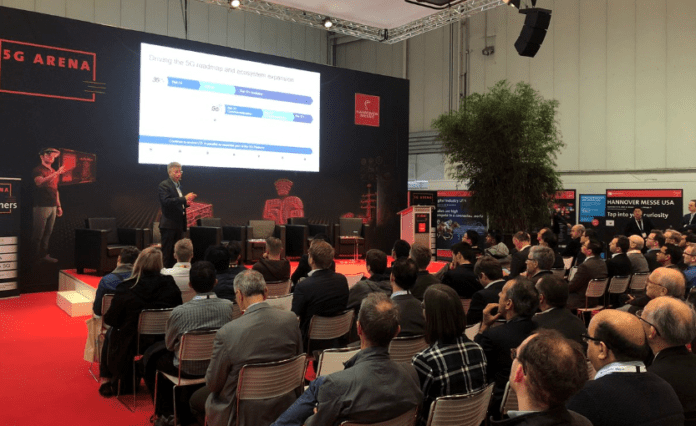HANNOVER, Germany–There’s widespread consensus among the industrial companies on hand for Hannover Messe that 5G will be a major factor in the future of high-value verticals like manufacturing. But, just like consumer 5G services, it won’t happen overnight. That’s why Qualcomm is working on continued development of the 5G New Radio standard while taking a collaborative approach to bringing 5G to industries.
Yongbin Wei, Qualcomm’s senior director of research, gave a presentation during Hannover Messe looking ahead to refinements of 5G NR coming in 3GPP’s Release 16 that speak directly to industrial internet of things-type applications, particularly reliability and time-sensitive networking.
He gave the example of industrial robotics, noting, “The unique thing about this is latency and reliability is much more stringent. To support that…Release 16 will bring a couple of enhancements to better use 5G.”
He also discussed the challenging radio environments present in varying types of industrial facilities. “The question we are trying to figure out is how we can marry the 5G connectivity better with all the industry’s existing facilities. To ensure the high reliability, that is a challenge,” and the solution will be spatial technology that ensures redundancy if a single RF link is blocked or otherwise unable to provide the level of service needed for a given application.
“If you have multiple links, then if a certain link gets blocked or degrades, you have another link. That’s the benefit of spatial diversity,” Wei said.
Private networks are another major topic at Hannover Messe; in fact, Germany has dedicated frequencies in the 3.7 GHz band for private networks, similar to what U.S. regulators are doing around the 3.5 GHz CBRS band.
In a blog post, Wei wrote, “Private 5G networks can be deployed in any spectrum type, from licensed spectrum managed by mobile operators to shared spectrum…and now unlicensed spectrum such as 5 GHz and 6 GHz with NR-U.”
As it relates to LTE, we see unlicensed spectrum being aggregated with licensed bands for carriers to augment capacity (LAA) and standalone deployments for primarily IoT applications (MulteFire). Extend these concepts to 5G and you’ve NR-U. The 3GPP is currently working on study items for NR-U in 5 GHz and 6 GHz which could potentially be included in Release 16, as Wei mentioned.
In terms of developing an industrial ecosystem, Qualcomm and Nokia have set up a 5G network at Hannover Messe and a number of partners–Bosch Rexroth, Festo, Goetting, IFAK, Siemens, Weidmueller and Zeiss–are using for demonstrations at the trade fair.
Bosch’s SVP of Business Unit Automation and Electrification Solutions Heiner Lang said access to 5G “makes the factory of the future a reality. Solutions such as our 5G-connected mobile control panel that supports also safety features, make new operating concepts possible: one 5G control unit can address several machines as reliably as only wired individual units could in the past. Machines can become leaner, cheaper and easier to maintain.”

